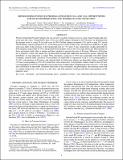Files in this item
Microlensing events by Proxima Centauri in 2014 and 2016 : opportunities for mass determination and possible planet detection
Item metadata
| dc.contributor.author | Sahu, K.C. | |
| dc.contributor.author | Bond, H.E. | |
| dc.contributor.author | Anderson, J. | |
| dc.contributor.author | Dominik, M. | |
| dc.date.accessioned | 2014-09-02T08:31:02Z | |
| dc.date.available | 2014-09-02T08:31:02Z | |
| dc.date.issued | 2014-02-20 | |
| dc.identifier | 145251613 | |
| dc.identifier | fec8a54e-3a83-4007-a37f-dd60ce38e37b | |
| dc.identifier | 84893537968 | |
| dc.identifier | 000334584700031 | |
| dc.identifier.citation | Sahu , K C , Bond , H E , Anderson , J & Dominik , M 2014 , ' Microlensing events by Proxima Centauri in 2014 and 2016 : opportunities for mass determination and possible planet detection ' , Astrophysical Journal , vol. 782 , no. 2 , 89 . https://doi.org/10.1088/0004-637X/782/2/89 | en |
| dc.identifier.issn | 0004-637X | |
| dc.identifier.other | ORCID: /0000-0002-3202-0343/work/75996668 | |
| dc.identifier.uri | https://hdl.handle.net/10023/5311 | |
| dc.description | Partial support for this research was provided by NASA through grant GO-12985 from the Space Telescope Science Institute, which is operated by the Association of Universities for Research in Astronomy, Inc., under NASA contract NAS5-26555. K.S. acknowledges support from the European Southern Observatory, the Institute for Theory and Computation at the Harvard-Smithsonian Center for Astrophysics, and the Institute for Advanced Study at Princeton for sabbatical visits, during which parts of this work were carried out. M.D. is thankful to the Qatar National Research Fund (QNRF), member of the Qatar Foundation, for support through grant NPRP 09-476-1-078. | en |
| dc.description.abstract | We have found that Proxima Centauri, the star closest to our Sun, will pass close to a pair of faint background stars in the next few years. Using Hubble Space Telescope (HST) images obtained in 2012 October, we determine that the passage close to a mag 20 star will occur in 2014 October (impact parameter 1.″6), and to a mag 19.5 star in 2016 February (impact parameter 0.″5). As Proxima passes in front of these stars, the relativistic deflection of light will cause shifts in the positions of the background stars of ~0.5 and 1.5 mas, respectively, readily detectable by HST imaging, and possibly by Gaia and ground-based facilities such as the Very Large Telescope. Measurement of these astrometric shifts offers a unique and direct method to measure the mass of Proxima. Moreover, if Proxima has a planetary system, the planets may be detectable through their additional microlensing signals, although the probability of such detections is small. With astrometric accuracies of 0.03 mas (achievable with HST spatial scanning), centroid shifts caused by Jovian planets are detectable at separations of up to 2.″0 (corresponding to 2.6 AU at the distance of Proxima), and centroid shifts by Earth-mass planets are detectable within a small band of 8 mas (corresponding to 0.01 AU) around the source trajectories. Jovian planets within a band of about 28 mas (corresponding to 0.036 AU) around the source trajectories would produce a brightening of the source by >0.01 mag and could hence be detectable. Estimated timescales of the astrometric and photometric microlensing events due to a planet range from a few hours to a few days, and both methods would provide direct measurements of the planetary mass. | |
| dc.format.extent | 9 | |
| dc.format.extent | 1509224 | |
| dc.language.iso | eng | |
| dc.relation.ispartof | Astrophysical Journal | en |
| dc.subject | Astrometry | en |
| dc.subject | Gravitational lensing: micro | en |
| dc.subject | Planetary systems | en |
| dc.subject | Stars: individual (Proxima Centauri) | en |
| dc.subject | QB Astronomy | en |
| dc.subject | QC Physics | en |
| dc.subject.lcc | QB | en |
| dc.subject.lcc | QC | en |
| dc.title | Microlensing events by Proxima Centauri in 2014 and 2016 : opportunities for mass determination and possible planet detection | en |
| dc.type | Journal article | en |
| dc.contributor.sponsor | The Royal Society | en |
| dc.contributor.institution | University of St Andrews. School of Physics and Astronomy | en |
| dc.identifier.doi | https://doi.org/10.1088/0004-637X/782/2/89 | |
| dc.description.status | Peer reviewed | en |
| dc.identifier.grantnumber | UF100010 / UF130581 | en |
This item appears in the following Collection(s)
Items in the St Andrews Research Repository are protected by copyright, with all rights reserved, unless otherwise indicated.

